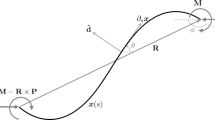Abstract
All soft tissues are modeled as either one-dimensionalstrings, two-dimensionalmembranes, or three-dimensionalsolids. Attention is restricted to tissues in which one of the principal stress components is large and positive in comparison with the other negligible components. Results indicate the following:
-
(1)
If a deformed string isconstrained to lie on a surface and is free of tangential pressure, the tension is carried by rays which are geodesics of the surface. If a string or membrane isfree to deform in space without normal pressure, the tension rays are straight lines. If a membrane deforms without tangential surface loads, the tension rays are always geodesics on the deformed surface. If a solid deforms without body forces, the tension rays are straight lines.
-
(2)
The stress in a string is a constant if the string is free of tangential pressure and has constant cross-sectional area. The stress in flat tension fields free of tangential surface loads decays inversely with distance along a tension ray from the edge of regression. The stress in a spherically symmetric tension field free of body forces decays inversely with the square of the distance from the center of the sphere.
-
(3)
Stress singularities can occur in soft tissues, such as at the corners of a closed rectangular hole in a flat membrane strip.
-
(4)
The tension rays in the torsion of soft annular membranes are more steeply inclined from the radial direction than the tension rays for hard metals equally displaced.
Similar content being viewed by others
Literature
Danielson, D. A. 1973. “Human Skin as an Elastic Membrane.”J. Biomech.,6, 539–546.
— 1975. “On Membranes, Tension Fields, and the Human Skin.”J. Appl. Mech.,42, 232–233.
— and S. Natarajan. 1975. “Tension Field Theory and the Stress in Stretched Skin.”J. Biomech.,8, 135–142.
Finlay, B. 1971. “The Torsional Characteristics of Human SkinIn Vivo”Bio-Med. Eng.,6, 567–573.
Fung, Y. C., B. W. Zweifach and M. Intaglietta. 1966. “Elastic Environment of the Capillary Bed.”Circulation Res.,19, 441–461.
Fung, Y. C. 1975. “Stress, Deformation and Atelectasis of the Lung.” To be published inCirc. Res.
Green, A. E. and W. Zerna. 1968.Theoretical Elasticity. p. 57. London: Oxford Univ. Press.
Iai, T. 1943. “Method of Solution by Means of the Theorem of Maximum Strain Energy of the Problems of Elasticity.”J. Soc. Aeron. Sci. Nippon,10, 276–298.
Kondo, K. 1938. “The General Solution of the Flat Tension Field.”J. Soc. Aeron. Sci. Nippon,5, 887–901.
—. 1943. “On the General Theory of the Curved Tension Field.”J. Soc. Aeron. Sci. Nippon,10, 289–396.
—, T. Iai, S. Moriguti and T. Murasaki. 1955. “Tension Field Theory.”Memoirs of the Unifying Study of the Basic Problems in Engineering Sciences by Means of Geometry I. (Ed. K. Kondo, pp. 417–441. Tokyo: Gakujutsu Bunken Fukyu-Kai.
Mansfield, E. H. 1969. “Tension Field Theory.”Proc. 12th Int. Cong. App. Mech. (Eds M. Hetenyi and W. G. Vincenti) pp. 305–320. New York: Springer.
Mikulus, M. M., Jr. 1964.Behavior of a Flat Stretched Membrane Wrinkled by the Rotation of an Attached Hub. NASA TN D-2456.
Murphy, G. M. 1960.Ordinary Differential Equations and Their Solutions. p. 25. Princeton: D. van Nostrand.
Reissner, E. 1939. “On Tension Field Theory.”Proc. 5th Int. Cong. App. Mech. (Eds. J. P. Den Hartog and H. Peters) pp. 88–92.
Sanders, R. 1973. “Torsional Elasticity of Human SkinIn Vivo.”Plügers Arch.,342, 255–260.
Stein, M. and J. M. Hedgepeth. 1961.Analysis of Partly Wrinkled Membranes. NASA TN D-813.
Vasblom, D. C. 1967. “Skin Elasticity—In Vivo Measurements at Small Deformations.”Digest of the 7th Int. Conf. on Med. and Biol. Eng., Stockholm.
Wagner, H. 1929. “Flat Sheet Metal Girders With a Very Thin Metal Web..”Z. Flugtechn. Motorluftschiffahrt. 20:200. Translation into English: NACA TM 604-606.
— and W. Ballerstedt. 1935. “Über Zugfelder in Ursprünglich Gekrümmten, Dünnen Blechen bei Beanspruchung durch Schubkräfte.”Luftfahrtforschung.,12, 70–74.
Weatherburn, C. E. 1927.Differential Geometry of Three Dimensions I. p. 136. Cambridge, England: University Press.
Author information
Authors and Affiliations
Additional information
This research was financially supported by Public Health Service Research Career Development Award 5KO4 GM70733-03 from the Institute of General Medical Sciences.
Rights and permissions
About this article
Cite this article
Danielson, D.A. Tension field theories for soft tissues. Bltn Mathcal Biology 40, 161–182 (1978). https://doi.org/10.1007/BF02461433
Received:
Revised:
Issue Date:
DOI: https://doi.org/10.1007/BF02461433




